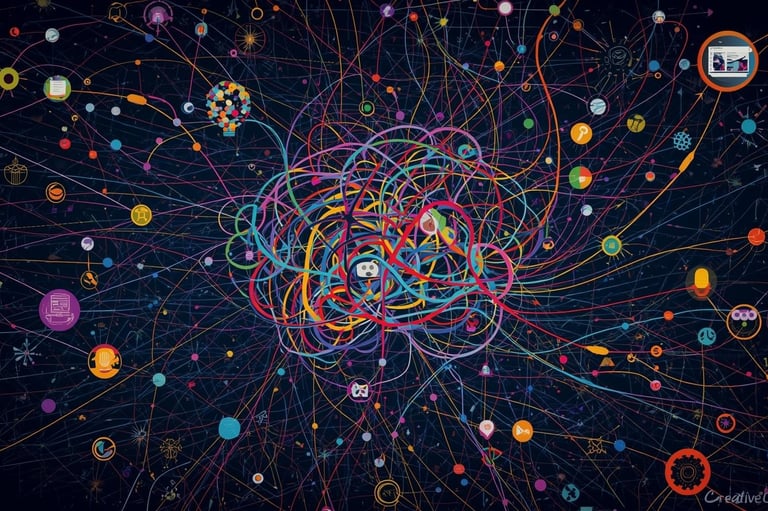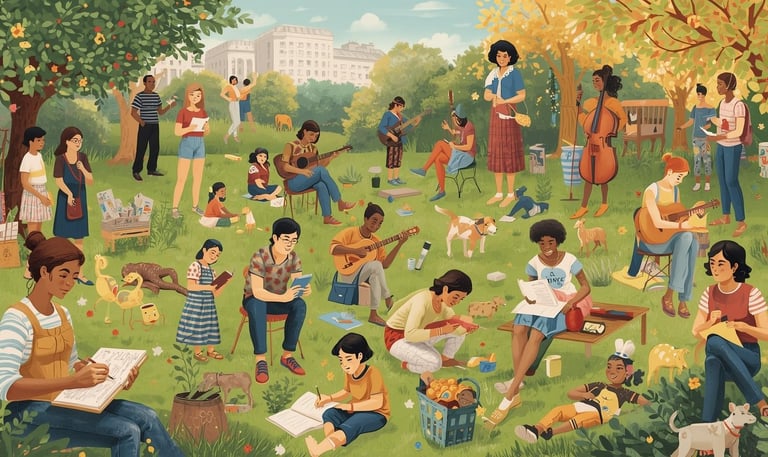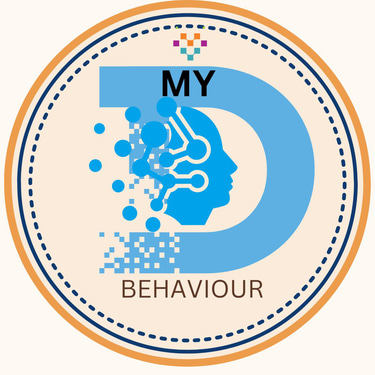Daily Cognitive Practices: Becoming Immortal Through Creativity
“Build daily habits that train your cognitive mind to create immortal ideas and lasting legacy.” Part 5
Gajanan L. Bhonde
9/26/202512 min read



Introduction to Daily Cognitive Practices
Daily cognitive practices are intentional activities designed to stimulate and enhance creative thinking. These practices serve as powerful tools that individuals can integrate into their everyday routines, fostering an environment where creativity can flourish. Embracing creativity is vital not only for personal growth but also for contributing positively to cultural evolution. When individuals engage in creative practices regularly, they cultivate skills and experiences that leave an enduring impact on their lives and the world around them.
The importance of creativity transcends individual expression; it plays a crucial role in problem-solving, innovation, and adaptation in an ever-changing society. Individuals who nurture their creative capacities often find increased life satisfaction and fulfillment, as they unlock new ways of seeing the world. By consciously dedicating time to cognitive practices, individuals can tap into their unique perspectives, ultimately resulting in a rich legacy of ideas and actions that can inspire future generations.
Daily cognitive practices encompass a wide variety of activities, such as journaling, brainstorming sessions, or engaging in art forms like painting and music. Each of these activities contributes to a broader cognitive framework that promotes flexible thinking and originality. Moreover, the act of creation itself establishes a sense of connection to something greater, fostering a feeling of immortality through the ideas that an individual generates and shares.
As one embarks on the journey of integrating creativity into daily life, it is essential to recognize that these practices are not solely confined to artistic endeavors. They can be applied in various contexts, including professional environments, academic settings, and personal relationships. The cultivation of creativity through these daily practices ultimately enriches not just the individual, but also contributes to the collective cultural narrative that shapes human experience.
Cognitive Training Techniques: Journaling, Mind-Mapping, and 'What If' Questioning
Cognitive training can significantly enhance creativity and problem-solving abilities. Among the various techniques, journaling, mind-mapping, and 'what if' questioning stand out for their accessibility and effectiveness. Each of these methods fosters unique cognitive benefits that stimulate creative thinking.
Journaling serves as a powerful tool for self-reflection and idea generation. By dedicating time each day to write thoughts, feelings, and observations, individuals can gain clarity on issues and explore their inner landscape. This technique not only aids in emotional processing but also helps organize thoughts, leading to improved focus. To incorporate journaling into a daily routine, setting aside a specific time—whether in the morning or before bed—can facilitate consistency. Whether handwritten or typed, the key is to create a comfortable environment that encourages open expression.
Mind-mapping, on the other hand, visually represents ideas and concepts, allowing individuals to see connections between them. This technique promotes the exploration of multiple perspectives, facilitating divergent thinking. By starting with a central idea and branching out with related topics, one can create a comprehensive overview that enables the discovery of innovative solutions. Practical tips for effective mind-mapping include using colors or images to enhance engagement, as well as limiting the time spent on each map to encourage quick and creative thought generation.
Lastly, 'what if' questioning stimulates the imagination and encourages the extrapolation of ideas. By posing hypothetical scenarios, individuals can break free from conventional thinking patterns and explore possibilities beyond their current reality. Integrating this method into daily life can be as simple as setting aside time during a brainstorming session to formulate at least five 'what if' questions related to a challenge or project. Collectively, these cognitive training techniques—journaling, mind-mapping, and 'what if' questioning—offer valuable strategies to bolster creativity and innovative thinking.
The Science of Habit Stacking for Creativity Enhancement
Habit stacking is a psychological strategy that leverages the concept of building upon existing routines to facilitate the formation of new habits. In the realm of creativity enhancement, this method allows individuals to amalgamate their creative endeavors with established daily activities, thereby fostering an environment conducive to creative thought. The fundamental principles of habit stacking are grounded in behavioral psychology, particularly the understanding of cue-routine-reward frameworks, as proposed by researchers like Charles Duhigg in his book “The Power of Habit.”
The efficacy of habit stacking lies in the ability to attach a new, creative habit to a pre-existing routine. For instance, an individual might choose to engage in a brief morning journaling session immediately following their usual coffee-making ritual. In this case, the act of making coffee serves as the cue that triggers the subsequent creative outlet. Over time, this integration helps to reinforce the newly formed habit, ensuring that creativity becomes an intentional part of the daily regimen.
Moreover, the science of habit formation suggests that consistency is vital for success. The brain benefits from repetition, and when creative habits are consistently incorporated into daily routines, they become more automatic and ingrained. This increases the likelihood of maintaining creativity as a priority in one’s life. To effectively implement habit stacking, individuals can begin by selecting one or two small, achievable creative activities, such as brainstorming ideas while commuting or doodling during lunch breaks, and pair them with existing habits.
In conclusion, habit stacking serves not only as a method for maintaining consistency in creative practices but also as an effective technique for enhancing overall creativity. By strategically intertwining creative activities with the flow of daily life, individuals can cultivate a stronger, more enduring creative identity that is effortlessly woven into their routine.
Extraordinary Stories of Ordinary People
Throughout history, countless individuals have demonstrated that extraordinary achievements can emerge from seemingly ordinary lives. These stories remind us that creativity is not reserved for the elite or highly educated but is accessible to everyone willing to nurture their innate talents. One such story is that of J.K. Rowling, a single mother who faced adversity and struggled with unemployment. Through her determination and creativity, she penned the remarkable Harry Potter series, which has captivated millions worldwide. Rowling's journey illustrates how creative expression can lead to impactful contributions that resonate across generations.
Another inspiring example is that of Vincent van Gogh, a post-impressionist painter whose fame blossomed long after his untimely death. Despite facing mental health challenges and a lack of recognition during his lifetime, van Gogh's artistic vision gained posthumous acclaim, leaving an indelible mark on the art world. His expressive use of color and bold brushwork has inspired countless artists, highlighting how one's creative output can achieve immortality despite initial struggles.
The story of Maya Angelou also stands out as a testament to the power of creativity. As a renowned poet and civil rights activist, she used her words to uplift and empower marginalized communities. Angelou's memoir, "I Know Why the Caged Bird Sings," continues to be a pivotal work in American literature, showcasing how a single voice can instigate dialogue and promote social change. Her courage to share her life experiences through poetry and prose demonstrates how personal creativity can captivate audiences, echoing through time.
These narratives underscore the idea that ordinary individuals, through their creative endeavors, can leave a lasting legacy. Each story serves as a motivation for readers to recognize their potential for creativity, encouraging everyone to explore their unique talents and make meaningful contributions to the world. The essence of creativity lies within us all, waiting to be unleashed and shared.
The Impact of Small Daily Acts of Creativity on Personal and Cultural Life
Engaging in small daily acts of creativity plays a critical role in shaping both personal growth and cultural heritage. These simple, consistent creative practices allow individuals to express themselves, harness their imaginations, and explore new perspectives. Over time, such acts accumulate, creating a foundation for personal identity and contributing to a vibrant cultural landscape. When individuals engage in creative endeavors, whether it be through painting, writing, or even cooking, they not only develop their unique voice but also connect with broader societal narratives.
Regular participation in creative activities fosters a sense of belonging and community. As individuals express their creativity, they often share their works with others, inviting dialogue and collaboration. This interaction nurtures relationships among peers, family members, and within the community, thus reinforcing social bonds. Such grassroots creativity draws from local traditions and experiences, enriching cultural narratives. For instance, local art exhibits can showcase the diversity of creativity present within a community, reflecting collective experiences and aspirations.
Moreover, acts of creativity can elicit a profound emotional response, influencing the environment and atmosphere within communities. Creative expressions, such as murals or community theater, can instigate conversations on social issues and challenge prevailing narratives. This ripple effect of creativity highlights its ability to weave together personal experiences with cultural expressions, creating a shared heritage that binds individuals across different backgrounds. Therefore, it is essential to recognize and nurture these small creative practices, as they contribute significantly not only to the personal journeys of individuals but also to the rich tapestry of cultural life.
Final Inspiration: Your Creativity as Your Forever Memory
As we reflect upon the notion that creativity serves as a powerful conduit for personal expression, it becomes evident that our creative endeavors are not merely artifacts of our time, but rather resonant echoes that transcend mortality. Each painting, poem, or invention we create stands as a testament to our individual experiences and perspectives, etching our existence into the fabric of history. In this sense, creativity acts as a powerful means of achieving a form of immortality, allowing us to leave a mark that reverberates long after we are no longer here.
The essence of creativity lies in its ability to invoke emotions, provoke thoughts, and inspire future generations. Renowned author and artist, Anaïs Nin, once famously stated, “We do not see things as they are, we see them as we are.” This sentiment encapsulates the personal connection we forge with our creative expressions, reflecting not only our internal landscapes but also shaping the world around us. By embracing our innate creativity, we cultivate a legacy that is uniquely ours, ensuring that our thoughts, feelings, and aspirations are infused with life long after we depart.
Moreover, engaging in creative practices fosters a deeper connection with ourselves and our communities. It encourages us to share our stories, our fears, and our joys, building bridges that connect us to one another across different cultures and generations. The act of creating can be a profound means of communication, anchoring our place in the narrative of humanity. As you embark on your own creative journey, remember that every stroke of the brush, every word penned, and every moment spent in creation is a tribute to your existence. Therefore, let your creativity flourish, for it is through these expressions that you promise to live on, leaving a lasting memory that echoes through time.
Practical Tips for Integrating Creativity into Daily Life
Integrating creativity into daily routines is essential for enhancing cognitive function and fostering a mindset that values innovation. To begin, dedicate a specific time each day for creative pursuits. This could be as simple as spending 15-30 minutes in the morning or evening to explore your interests, be it writing, drawing, or engaging in music. Structuring this time helps normalize creativity as a vital part of your day.
Next, create a stimulating environment that encourages creative thoughts. A workspace free from distractions, adorned with inspiring materials such as art pieces, books, or even nature, can significantly enhance creative potential. Consider making small changes to your surroundings; for instance, rearranging furniture or introducing new colors can renew your perspective and stimulate your imagination.
Additionally, explore the concept of constraints within creativity. While it may seem counterintuitive, setting limitations can foster innovative thinking. For example, challenge yourself to write a poem with a specific number of words or create a painting using a restricted color palette. Such practices can often lead to unexpected and rewarding creative outcomes.
Another practical tip is to embrace collaboration. Engaging with peers in creative projects can broaden your perspectives and provide motivation. Attend workshops, join clubs, or even collaborate online with like-minded individuals. This interaction often leads to a sharing of ideas and techniques, enhancing one’s own creative skills.
Lastly, do not shy away from exploring various creative mediums. Diversifying your approach—such as trying photography if you primarily write or vice versa—can unlock new pathways for thought and expression. Remember that creativity is a muscle that strengthens with consistent practice; embracing these strategies can effectively weave creativity into the fabric of your daily life.
HOW TO PRACTICE CREATIVITY :
Daily Cognitive Practices – Becoming Immortal Through Creativity
Introduction: Immortality Is Built One Day at a Time
We often imagine immortality as something grand—masterpieces, inventions, world-changing philosophies. But the truth is, immortality begins in small, daily acts of creativity.
Every immortal creator—whether Shakespeare, Picasso, Einstein, or Mirabai—was first an ordinary human who nurtured their mind daily. Their immortal works were not flashes of luck but the harvest of disciplined practices, habits, and cognitive rituals.
This blog explores how the cognitive mind can be trained every day to produce ideas, art, and actions that outlive us. It’s about building a legacy mindset not through chance but through intentional practice.
Part 1: Why Daily Cognitive Practice Matters
The brain is not a fixed machine—it is neuroplastic. Like muscles in the body, it grows stronger with consistent use.
A poet who writes daily trains their brain to notice metaphors everywhere.
A scientist who questions daily builds mental muscles of curiosity.
An entrepreneur who sketches ideas daily develops problem-solving reflexes.
Without practice, creativity remains potential energy. With practice, it becomes kinetic energy—ideas in motion.
Part 2: The Science of Daily Creativity
Neuroscience shows that habit + repetition changes the brain:
Hebbian Learning: “Neurons that fire together, wire together.” The more you practice a creative act, the faster and stronger it becomes.
Flow State Activation: Daily practice lowers the threshold for entering flow, that timeless state where creativity feels effortless.
Memory Consolidation: Repetition allows ideas to move from short-term memory into long-term storage, making them easier to recall and build upon.
👉 Daily practices are not boring rituals; they are the brain’s immortality workshops.
Part 3: Journaling – The Seed Bank of Immortality
Many immortal thinkers were obsessive journal keepers:
Leonardo da Vinci’s notebooks contained sketches of flying machines and anatomy studies.
Virginia Woolf’s diaries became the foundation for much of her published work.
Anne Frank’s simple reflections became a universal legacy.
How to Practice:
Write one page a day, without editing.
Capture not just events but questions, emotions, metaphors, and sparks.
Treat your journal as a seed bank—you don’t know which idea will sprout decades later.
Part 4: Mind-Mapping – Connecting Dots That Others Miss
The cognitive mind thrives on connections. A daily mind-map (visual brainstorming) helps train the brain to see links between unrelated things.
Example: Einstein connected physics and imagination by visualizing riding on a beam of light.
Practice:
Start with a central word (e.g., “creativity”).
Branch out with random associations (art, problem-solving, risk, beauty).
Push yourself to connect unrelated branches—this is where innovation lives.
Part 5: “What If” Questioning – Curiosity as a Legacy Engine
Children ask “What if?” naturally, but adults often silence curiosity. Yet, immortality often begins with a single question:
What if humans could fly? (Da Vinci → Wright Brothers → SpaceX)
What if freedom could be achieved without violence? (Gandhi → Martin Luther King Jr.)
What if computers could fit into pockets? (Jobs → Smartphones).
Practice:
Ask one bold “What if?” daily.
Write down potential answers—even the impossible ones.
Revisit them after weeks—you’ll notice new connections.
Part 6: The Role of Storytelling in Daily Practice
Storytelling is humanity’s oldest legacy tool. Every day, tell one small story:
To a friend, to your journal, or to yourself.
About a failure, a funny incident, or a dream.
Over time, you will build a personal archive of narratives that others can carry forward. Remember: a story told once may die, a story repeated becomes immortal.
Part 7: Rituals That Anchor Creativity
Immortal creators often used rituals to enter the creative zone:
Maya Angelou wrote in hotel rooms with nothing but a notebook.
Beethoven had coffee with exactly 60 beans every morning.
Murakami runs daily before writing.
Practice:
Choose a small ritual (tea, music, a walk).
Perform it daily before your creative act.
Train your brain to associate the ritual with creative readiness.
Part 8: Community as a Daily Practice
No idea becomes immortal alone. Daily connection with others amplifies creativity:
Kabir’s songs lived because villagers sang them together.
Open-source coding thrives because communities build on each other’s ideas.
Social media, when used wisely, becomes a legacy multiplier.
Practice:
Share one idea a day—small tweet, sketch, voice note.
Engage with others’ creativity; collaboration extends longevity.
Part 9: Ordinary People, Immortal Footprints
Immortality is not reserved for geniuses. Ordinary people leave timeless marks:
A grandmother’s recipe passed down generations.
A teacher’s words that shape thousands of lives.
A farmer’s traditional technique preserved in sustainable farming.
👉 The daily acts of ordinary lives often become cultural DNA for future generations.
Part 10: Digital Tools for Daily Immortality
In the digital age, leaving a legacy is easier than ever:
Blogs preserve your reflections.
Podcasts and YouTube store your voice and ideas.
AI archiving ensures your work may live centuries in data clouds.
But immortality still requires discipline + resonance. Without clarity, digital noise swallows your work.
Part 11: Building Your Legacy Routine (A Practical Blueprint)
Here’s a sample daily routine for cultivating immortal creativity:
Morning (15 min): Journal 1 page.
Afternoon (10 min): Mind-map a random idea.
Evening (10 min): Ask and record a “What if?” question.
Night (5 min): Share one small insight online or with a friend.
Total time = 40 minutes a day.
Result = A lifetime archive of immortal seeds.
Conclusion: Your Creativity Is Your Forever Memory
Immortality is not a myth. It’s a choice. Every day, your cognitive mind has the power to plant seeds of thought, emotion, and imagination that will continue to grow even when you are gone.
When you practice daily journaling, questioning, storytelling, and sharing, you’re not just training your brain—you’re designing your future memory in the world’s consciousness.
One day, long after your body is gone, someone may read your words, hum your tune, use your invention, or live by your wisdom. That is true immortality.
So begin today. Plant your creative seeds. Water them with practice. Watch them grow into trees that will shade countless generations. 🌳✨










